|
There was no sign of any activity in the caravan park office the next morning, so Karen and I left Elle and Mel leaning up against the shed where they were to be stored, hoping they would soon be noticed by the park owners. We walked into town to pick up the bus. Incredibly, Greyhound had somehow managed to stuff up our booking again. The driver had a reservation for Mrs Davis and bicycle, but nothing for me. Luckily, the bus was only one-third full, and there was no problem getting me a seat.
The trip to Perth was like most long distance bus journeys in Australia - not much fun. A ten minute stop in Kalgoorlie, a fast food lunch in Yellowdine, and Ted Danson in Loch Ness on the video as we rolled through the wheat belt to afternoon tea at Meckering, whose only claim to fame was being flattened in an earthquake in 1968. Somewhere along this stretch we passed the Dutch cyclist we had followed out of Esperance three days earlier. Our sentiments on seeing him were the same as we felt for all touring cyclists like us. Poor bastard. Must be a bit strange. Why would you want to do something like that?
As we approached Northam late in the afternoon, the bus driver woke us from our reverie with a bit of tourist commentary, asking us to be on the lookout for white swans on the river when we drove through the town. Nobody else on the bus gave a damn, but Karen and I were instantly alert. White swans are actually Mute Swans, an introduced bird species on the Australian bird list, and one which we had not seen in the wild. When we reached the river we looked left and right and quickly spotted a white swan on a gravel bank. You bewdy! Tick!
The bus terminated at the East Perth railway station. Karen rang Peter to ask the name of the station nearest to his house, then we ran the gauntlet of automatic ticketing machines and inter-urban timetables and eventually found ourselves on the Armadale line. We disembarked at Beckenham with a long walk in front of us, but a BYO Chinese Restaurant with a bottle shop just across the road made the hike much more enjoyable. Over dinner Karen and I pondered the different course our lives had taken. Two days ago we had expected to be in Port Augusta now, preparing to ride back across the Nullarbor, yet here we were in Perth, a couple of thousand kilometres away.
Peter drove us to the Brits-Australia office the next morning, staying with us until we had accepted delivery of the vehicle, a 4WD manual diesel high-top Toyota Landcruiser. The back of the vehicle had been converted into a camper, with a sink, stove, refrigerator and seats which converted into a bed. Once we loaded the bikes and all of our gear into the back, however, it would be too much hassle to unload them all the time, so we would continue to live in our tent. Our MasterCard was slugged for seven hundred and twenty dollars - six days hire at fifteen dollars per day, an extra five dollars per day to remove the excess from the insurance, a five hundred dollar bond and a one hundred dollar cleaning bond. Assuming we delivered the vehicle on time, undamaged and clean, we would get the two bonds refunded in Adelaide.
We also had to pay for our own fuel. The Landcruiser had two ninety litre fuel tanks, one of which was full initially and which had to be full when we delivered it. We drove straight to a petrol station and filled the second tank, wanting to take advantage of the cheaper city fuel prices, then we headed out of the city. Only thirty eight kilometres down the road I was stopped by a very attractive, young policewoman who asked me to blow into a little bag. The breathalyser showed I was sober (for a change).
Our return to Norseman was as uneventful as the bus trip, apart from a phone call in Coolgardie. Karen phoned a friend called John who currently lived in Kalgoorlie, thinking she would only be charged the cost of a local call, totally forgetting she was dialling a mobile number. By the time she noticed that the balance left on the phone-card was rapidly dwindling, Karen barely had enough time and money left to explain to John that we were on a tight schedule and could not drop in for a visit.
We arrived back at Norseman an hour after dark, with over seven hundred kilometres of driving behind us. Elle and Mel were retrieved safely, the tent erected, dinner cooked and eaten, showers had, and we eventually hit the sack after eleven o'clock, totally knackered after a very long day.
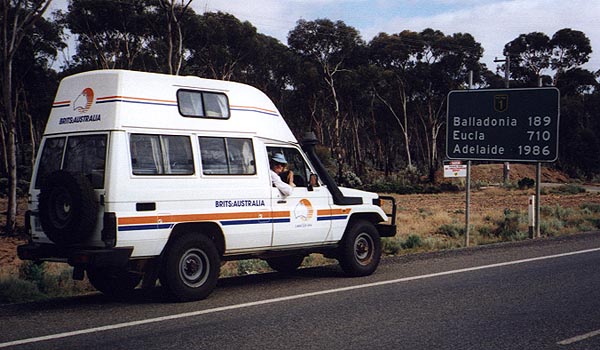
Our Brits-Australia 4WD
In the morning it took us about an hour to load the bikes and all our gear safely so that no damage would be done to either the bikes or the Landcruiser. We topped up the fuel tanks, assuming that Norseman fuel prices would be lower than Nullarbor roadhouse prices, and hit the road. After an hour and a half we stopped for morning tea at Newman Rocks, a man-made waterhole on a natural rock catchment. The day became a succession of driver changes after that, with Karen taking over at Balladonia, me driving through Caiguna and Cocklebiddy to Madura, Karen driving from there to Mundrabilla and me finishing off the final stretch to Eucla. Another seven hundred kilometre day.
Karen and I always share the driving load on long trips. I have total confidence in her ability - after all, it was Karen who taught me to drive - but she does have one bad habit. She tends to fall asleep when driving long distances. I was especially concerned when we hit the longest straight stretch of road in Australia - one hundred and forty six point six kilometres - between Balladonia and Caiguna, but Karen handled it okay.
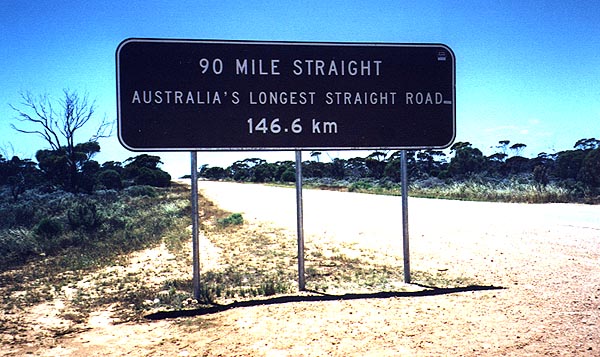
A bit of straight road
The highlights of the day included the Western Myall trees along the Roe Plain between Madura and Eucla, and the barren-ness of the terrain. It was barer than the Great Sandy Desert in Western Australia, and comparable to the areas north of Port Augusta and around Coober Pedy in South Australia. Amazingly, we had not even hit the actual desert yet!
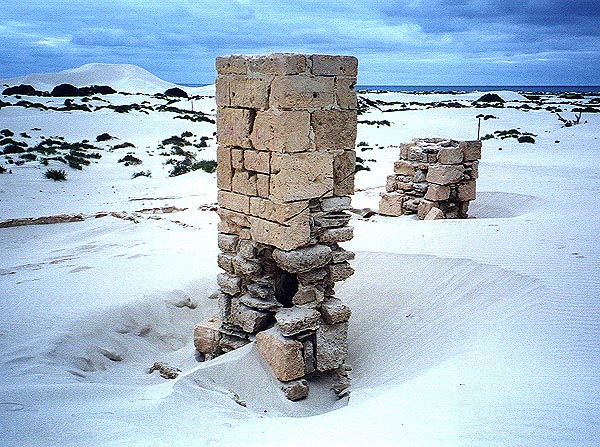
The old Eucla Telegraph Station
In the morning we drove past two memorials - one for the explorer John Eyre and the other for the overland telegraph workers - down to the old Eucla Telegraph Station near the coast. There is not much left to see of it any more, just a few stone walls and a chimney poking out of the shifting sand dunes. After taking a couple of photos we drove back up to the top of the escarpment and headed east again. We soon reached the imaginary line separating Western Australia from South Australia, pausing only briefly for the obligatory border crossing photo.
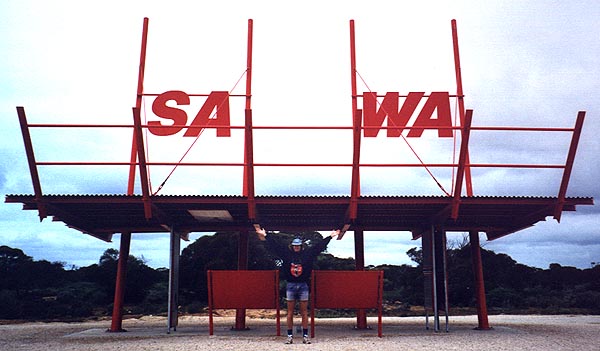
The border
The next two hundred kilometres of highway to Nullarbor Station pass close to the cliffs which drop vertically from the elevated plain to the pounding waves of the Great Australian Bite hundreds of feet below. A half dozen lookouts are dotted along this section, and we visited every one of them. The first couple were pretty impressive, but by the end Karen and I were pretty much cliffed out.
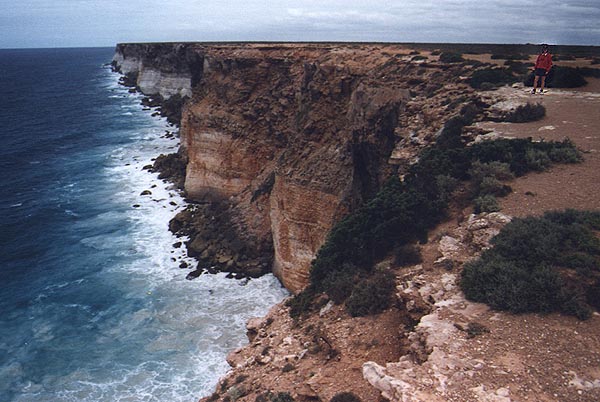
Nullarbor cliffs
Nullarbor Station came and went. So did Nundroo. At lunch I set my watch to South Australian time, but Karen made no such adjustment, arguing that her body clock was still on Western Australia time. Karen therefore finished lunch at 1:30pm while I finished it at 4pm. We drove on to Ceduna, filling the tanks for the first time since Norseman. The long range tanks saved us some money, with fuel in Ceduna being twenty cents a litre cheaper than at the border. Karen rang Brits-Australia and wheedled an extra day out of them, so instead of heading straight across the Eyre Peninsula to Port Augusta we could afford to detour via Port Lincoln. We followed the coast around to Streaky Bay where we camped for the night, having covered over two thousand kilometres in three days.
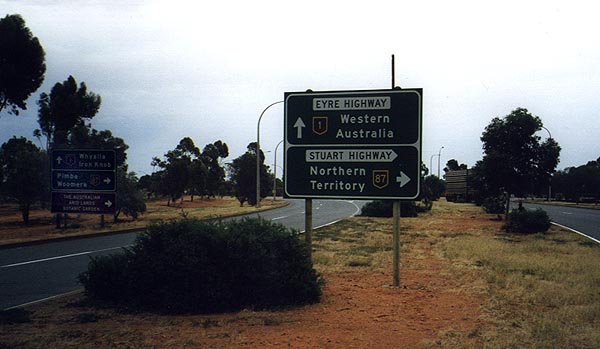
You don't see signs like this every day
We went to bed early or late that night, depending on whose watch you believed. As we settled down to sleep, I pointed out to Karen that she could have breakfast two and a half hours sooner if she was on South Australian time. She sat up, turned on the light and changed her watch immediately.
The following morning we drove out to Cape Labatt for a look at the only mainland sea-lion colony in Australia. From a lookout high above we gazed down on about three dozen sea-lions who dozed on the beach or frolicked in the water. Five or six fur seals basked on rocks further along the shore. It was pretty darned good.
A little while late we were at Murphy's Haystacks, a collection of large, rounded, granite rocks technically known as insulburgs. They were situated on private property and reached via an honesty box entry gate at a cost of a dollar per person. The rocks were pretty good, but the birds in the area were even better. Karen and I had our very first sighting of a White-browed Woodswallow. It can allegedly be found all over Australia and is considered quite common, yet we had seen none in almost four years of searching. We had been starting to believe that it was either extinct or part of some nationwide conspiracy to hoodwink unsuspecting birdwatchers.
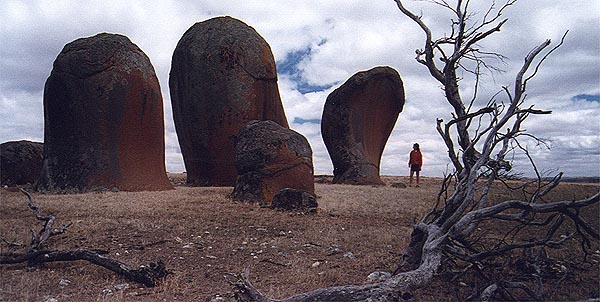
Murphy's Haystacks
Just before Elliston we turned off to follow a scenic cliff-top drive. The scenery was great, but Karen and I had almost reached the point where we did not care if we never saw another cliff again. After lunch we drove further south along the coast to the Cummings Monument Lookout, set high atop yet another cliff. Karen and I bemoaned the tendency in Australia for similar types of scenery to be lumped together. In Sydney it is beaches, in Queensland it is rainforests, and around Alice Springs it is gorges. The western end of South Australia has cliffs.
The lookout, however, was rather impressive, not because of the scenery which was admittedly spectacular, but because of a construction on a sea-stack just off the coast. A pair of Ospreys had chosen the top of the pillar of rock as the site of their nest, a massive collection of sticks about five feet high and three or four feet across. Like most Osprey nests, it seemed too exposed to support a growing chick, but the parents evidently knew what they were doing because the nest was occupied by three birds, two adults and an almost fully grown youngster. The entire scene was a joy to behold.
We made our way through some rather impressive hills - the Marble Range and Mounts Greenly, Frenchman and Dutton - to a lookout over Coffin Bay. Karen and I had always assumed, incorrectly as it turned out, that Coffin Bay was so named because of shipwrecks or dangerous waters, but an information board at the lookout informed us that the bay was named after Sir Isaac Coffin, a friend of Matthew Flinders. Karen had some romantic ideas about watching the sunset while sipping on champagne and dining on a couple of dozen oysters for which Coffin Bay is famous. Unfortunately we had arrived out of oyster season. Bugger!
After a non-romantic night we wasted no time in getting to Port Lincoln. With some trepidation we approached the counter at the post office, hoping that the package lost in Margaret River a hundred years ago was now available for collection. Amazingly, it was, along with another bundle of mail that Kevin had sent more recently! While Karen shopped for supplies, I sorted and read the mail.
A lot of the "news" I read was now rather old, but it was good to hear anyhow. Keith and Elaine, who had transported us around Ayer's Rock and King's Canyon in their camper, were now at a temporary ministry on Norfolk Island. Colin and Cheryl, the rangers at Lawn Hill, were now at Ravenshoe on the Atherton Tableland after a brief stint in Townsville. We had lots of letters from friends both old and new. We also had an invitation to a party - which had already been held, eight rolls of film for use in the south-west of Western Australia - which we had just left, and a couple of bottles of sunscreen for the arduous Nullarbor crossing - which we had just completed.
The sunscreen would not be needed now. Karen and I had decided that it would be meaningless to ride back across the Nullarbor. We had seen most of its sights, and had no desire to make the crossing just so we could say that we had done it. Somewhere between Norseman and Ceduna we had both come to the realisation that the cycling trip was over. Stopping now felt right. To go on would have been pointless.
Our two thousand kilometres bus passes still had about thirteen hundred kilometres on them, enough to get us to Canberra. From there we would only be two or three cycling days away from either Sydney or St Georges Basin, our destination dependant on where Karen's parents decided to spend Xmas. Karen rang the Greyhound people and booked seats on the bus leaving Adelaide on the afternoon of the day we would be returning the Landcruiser to Brits-Australia.
We were on our way home.
|






